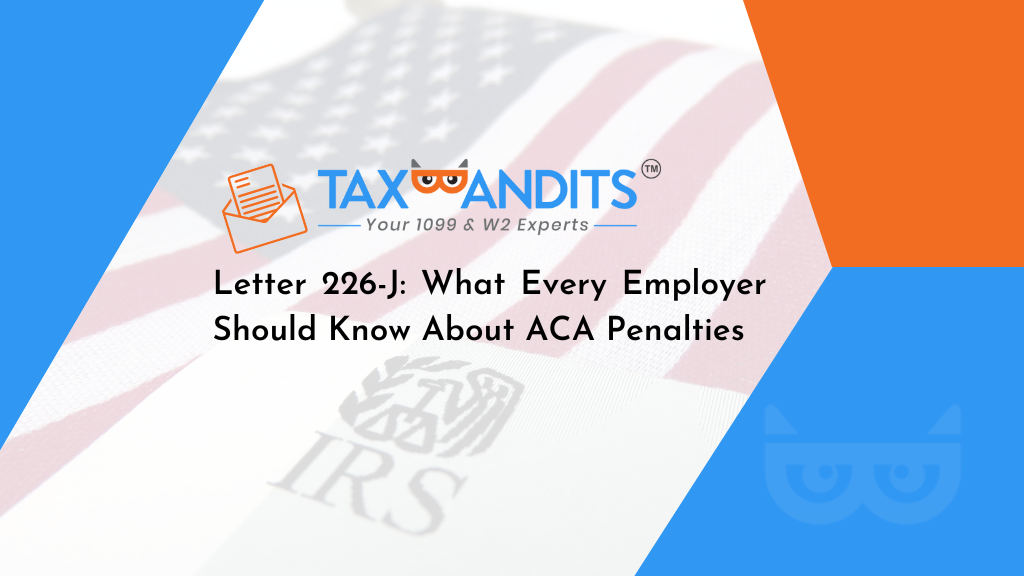Letter 226-J: What Every Employer Should Know About ACA Penalties
reading time: 16 minute(s)

Since the creation of the Affordable Care Act (ACA) over a decade ago, employers have been navigating a new and evolving landscape around health insurance coverage requirements and reporting requirements.
Completing accurate and timely ACA reporting is crucial for employers, failure to do so can lead to major IRS penalties. While penalties are an intimidating topic, filers need to arm themselves with the knowledge to address any potential errors in reporting proactively.
Here is an overview of Letter 226-J, what it is, and most importantly to your business, how to respond to this.
Employer-Shared Responsibility Provision: A Closer Look
Before we can completely tackle the topic of ACA reporting, we first need to understand the employer-shared responsibility provision that was introduced by the Affordable Care Act.
Under IRS Section 6056, otherwise referred to as the Employer Mandate, all applicable large employers must provide minimum essential coverage (MEC) to all their full-time and full-time equivalent employees.
The IRS defines an Applicable Large Employer (ALE) as any business with 50 or more full-time or equivalent employees on their payroll.
Full-time employees vs. Full-time equivalent employees
Under the Affordable Care Act, a full-time employee works a total of 130 hours a week (30 hours a week). A full-time equivalent is the combination of several part-time employees who work enough hours collectively as one full-time employee.
For example, if your business has two part-time employees working 15 hours a week, for a combined total of 130 hours per month, this is full-time equivalent.
Meeting the employer-shared responsibility provision is a requirement for all ALEs. The IRS is able to determine if an employer has met these requirements from their annual ACA reporting on Form 1095-C.
ACA Reporting Requirements on Form 1094-C and 1095-C
Using 1095-C Form, ALEs are required to report the following information to the IRS regarding each of their employees:
- The employee’s basic information (name, address, SSN, etc.)
- Whether the employee was offered MEC by their employer
- What kind of coverage was offered
- How many months of the year was the employee covered, if any
- How much the employee was required to contribute to their coverage
All of this information and more is required on Form 1095-C and allows the IRS to verify that the business met their employer-shared responsibility requirement.
What is Letter 226-J?
Now that we’ve covered the basics of why ALEs are required to complete ACA reporting and what their reporting requirements are, let’s get into the topic of penalties. When an employer is potentially liable for an employer-shared responsibility payment (ESRP), they will receive Letter 226-J.
This IRS notice is a notification that you have not met the reporting requirements under Section 6056. It is also possible that one of the employees was able to claim a premium tax credit for health insurance coverage on the marketplace, meaning that their employer offered them coverage that was not affordable.
There could be several different reasons for this, the employer may have submitted 1095-C forms that contained errors or may have failed to complete and submit the forms altogether.
It’s crucial to promptly respond to the notice, furnishing the required information to the IRS.
Responding to Letter 226-J
When it comes to responding to Letter 226-J – timing is important. The IRS will typically allow 30 days from the date on the letter to respond. Before responding, be sure to fully review and understand the contents of the letter.
The letter will come with attachments explaining the ESRP process and what your next steps are. Form 14764 will also be attached to the letter, this is what employers should use when responding to the notice.
For more information on responding to Letter 226-J, check out the IRS guidance, here.
Employers can choose to agree with the ESRP and submit the payment. Employers can also disagree, in this case, a complete explanation must be provided.
Additional Tips for Addressing Letter 226-J
If your business receives a Letter 226-J, there are a few things to keep in mind. Be sure to go back and review the 1095-C forms that you’ve submitted to the IRS for the tax year that they are inquiring about. This is the information that the IRS uses to determine the ESRP, therefore it will be important for you to reference whether you agree or disagree with the Letter 226-J.
You should also keep copies of all correspondence between you and the IRS, you may need to reference this in the future. If you have additional questions before officially responding to the letter, it is recommended that you reach out to the IRS directly, just be sure to do so in a timely manner.
An E-file Solution for Accurate ACA Reporting
ACA reporting on Form 1095-C can be a complex and time-consuming process. Now that the IRS has placed a new requirement for e-filing 10 or more information returns starting in 2024, ACA reporting will no longer be a paper process.
If your business is seeking a streamlined solution for e-filing ACA Forms 1095-C and 1094-C with the IRS, TaxBandits offers an excellent option. TaxBandits allows you to easily complete ACA reporting with bulk upload options to import your ACA form information, built-in audits using the IRS Business Rules, federal and state e-filing, and the ability to distribute employee copies via postal mail and secure online access.
Does your business need a more holistic approach to ACA reporting for the 2023 tax year? For a solution that includes ACA 1095 code generation, 1095 Form generation, additional data validations, and more, check out our sister product, ACAwise. They provide excellent full-service options to handle your ACA reporting.



Leave a Comment